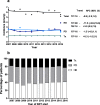Ten-year trends in epidemiology and outcomes of pediatric kidney replacement therapy in Europe: data from the ESPN/ERA-EDTA Registry
- PMID: 33483800
- PMCID: PMC8260419
- DOI: 10.1007/s00467-021-04928-w
Ten-year trends in epidemiology and outcomes of pediatric kidney replacement therapy in Europe: data from the ESPN/ERA-EDTA Registry
Abstract
Background: For 10 consecutive years, the ESPN/ERA-EDTA Registry has included data on children with stage 5 chronic kidney disease (CKD 5) receiving kidney replacement therapy (KRT) in Europe. We examined trends in incidence and prevalence of KRT and patient survival.
Methods: We included all children aged <15 years starting KRT 2007-2016 in 22 European countries participating in the ESPN/ERA-EDTA Registry since 2007. General population statistics were derived from Eurostat. Incidence and prevalence were expressed per million age-related population (pmarp) and time trends studied with JoinPoint regression. We analyzed survival trends using Cox regression.
Results: Incidence of children commencing KRT <15 years remained stable over the study period, varying between 5.5 and 6.6 pmarp. Incidence by treatment modality was unchanged over time: 2.0 for hemodialysis (HD) and peritoneal dialysis (PD) and 1.0 for transplantation. Prevalence increased in all age categories and overall rose 2% annually from 26.4 pmarp in 2007 to 32.1 pmarp in 2016. Kidney transplantation prevalence increased 5.1% annually 2007-2009, followed by 1.5% increase/year until 2016. Prevalence of PD steadily increased 1.4% per year over the entire period, and HD prevalence started increasing 6.1% per year from 2011 onwards. Five-year unadjusted patient survival on KRT was around 94% and similar for those initiating KRT 2007-2009 or 2010-2012 (adjusted HR: 0.98, 95% CI:0.71-1.35).
Conclusions: We found a stable incidence and increasing prevalence of European children on KRT 2007-2016. Five-year patient survival was good and was unchanged over time. These data can inform patients and healthcare providers and aid health policy makers on future resource planning of pediatric KRT in Europe.
Keywords: Dialysis; ESPN/ERA-EDTA Registry; Epidemiology; Hemodialysis; Pediatrics; Peritoneal dialysis; Transplantation.
Conflict of interest statement
The authors declare that they have no conflict of interest.
Figures





References
-
- Pippias M, Jager KJ, Kramer A, Leivestad T, Sánchez MB, Caskey FJ, Collart F, Couchoud C, Dekker FW, Finne P, Fouque D, Heaf JG, Hemmelder MH, Kramar R, De Meester J, Noordzij M, Palsson R, Pascual J, Zurriaga O, Wanner C, Stel VS. The changing trends and outcomes in renal replacement therapy: data from the ERA-EDTA Registry. Nephrol Dial Transplant. 2016;31:831–841. doi: 10.1093/ndt/gfv327. - DOI - PubMed
-
- ESPN/ERA-EDTA Registry: ESPN/ERA-EDTA Registry Annual Report 2016. Amsterdam UMC, location AMC, Department of Medical Informatics, Amsterdam, the Netherlands, 2018
-
- ERA-EDTA Registry: ERA-EDTA Registry Annual Report 2017. Amsterdam UMC, location AMC, Department of Medical Informatics, Amsterdam, the Netherlands, 2019
-
- Chesnaye N, Bonthuis M, Schaefer F, Groothoff JW, Verrina E, Heaf JG, Jankauskiene A, Lukosiene V, Molchanova EA, Mota C, Peco-Antić A, Ratsch IM, Bjerre A, Roussinov DL, Sukalo A, Topaloglu R, van Hoeck K, Zagozdzon I, Jager KJ, van Stralen KJ, ESPN/ERA-EDTA Registry Demographics of paediatric renal replacement therapy in Europe: a report of the ESPN/ERA-EDTA Registry. Pediatr Nephrol. 2014;29:2403–2410. doi: 10.1007/s00467-014-2884-6. - DOI - PubMed
Publication types
MeSH terms
Substances
LinkOut - more resources
Full Text Sources
Other Literature Sources
Research Materials

